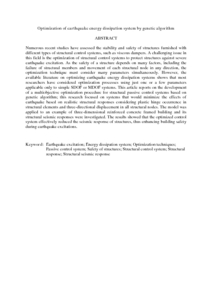Citation
Hejazi, Farzad and Toloue, Iraj and Jaafar, Mohd Saleh and Noorzaie, Jamaloddin
(2013)
Optimization of earthquake energy dissipation system by genetic algorithm.
Computer-Aided Civil and Infrastructure Engineering, 28 (10).
pp. 796-810.
ISSN 1093-9687; ESSN: 1467-8667
Abstract
Numerous recent studies have assessed the stability and safety of structures furnished with different types of structural control systems, such as viscous dampers. A challenging issue in this field is the optimization of structural control systems to protect structures against severe earthquake excitation. As the safety of a structure depends on many factors, including the failure of structural members and movement of each structural node in any direction, the optimization technique must consider many parameters simultaneously. However, the available literature on optimizing earthquake energy dissipation systems shows that most researchers have considered optimization processes using just one or a few parameters applicable only to simple SDOF or MDOF systems. This article reports on the development of a multiobjective optimization procedure for structural passive control systems based on genetic algorithm; this research focused on systems that would minimize the effects of earthquake based on realistic structural responses considering plastic hinge occurrence in structural elements and three-directional displacement in all structural nodes. The model was applied to an example of three-dimensional reinforced concrete framed building and its structural seismic responses were investigated. The results showed that the optimized control system effectively reduced the seismic response of structures, thus enhancing building safety during earthquake excitations.
Download File
![[img]](http://psasir.upm.edu.my/28738/1.hassmallThumbnailVersion/Optimization%20of%20earthquake%20energy%20dissipation%20system%20by%20genetic%20algorithm.pdf)  Preview |
|
PDF (Abstract)
Optimization of earthquake energy dissipation system by genetic algorithm.pdf
Download (85kB)
| Preview
|
|
Additional Metadata
Actions (login required)
 |
View Item |

